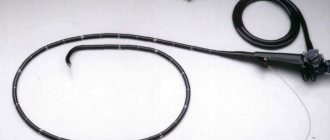Causes of bleeding from the anus
If you notice blood on toilet paper after bowel movements, even if the process of bowel movement occurs without pain, you should definitely consult a proctologist for advice in order to establish the cause of the bleeding, start treatment in a timely manner and avoid possible complications.
Why does blood appear from the anus after stool in both men and women:
- A fairly common factor is hemorrhoids (enlargement of the veins of the rectum). Scarlet blood appears from the anus during defecation.
- Anal fissure is the second most common cause of rectal bleeding. The disease is characterized by a burning sensation during bowel movements, sometimes accompanied by acute pain (patients describe it as cutting and then squeezing). Bloody discharge appears in both small and copious portions.
- Inflammatory diseases of the colon.
- The presence of benign formations (polyps). A characteristic symptom is the discharge of blood from the rectum after defecation. The blood is darker, often with mucus.
- The presence of a malignant tumor of the rectum. Blood of different colors may be released. Quite often, the blood released does not differ in any way from the blood that is released, for example, from hemorrhoidal tissue. And if the presence of hemorrhoidal disease only worsens the quality of life (hemorrhoidal tissue never degenerates into a malignant tumor), then the presence of a benign formation or a malignant tumor can be harmful to health and life-threatening, which is why you should not try to independently determine the source.
Only a coloproctologist can determine the true cause of bleeding from the anus and select the appropriate treatment. Timely diagnosis allows for effective conservative and minimally invasive treatment.
Does blood in stool depend on menstruation?
There are times when bloody mucus may be released during bowel movements the day before or during menstruation. There are several reasons that contribute to this situation:
What does a stool occult blood test show?
- The result of aggravated hemorrhoids (blood comes out along with feces). The disease can acutely manifest itself two days before the onset of menstruation. The approach of a new period of menstruation provokes an increase in the activity of blood flow to the pelvic area. In such a case, the hemorrhoidal node becomes inflamed and when visiting the toilet you can see blood in the stool.
- Endometriosis is a pathological process in which endometrial cells spread to neighboring organs of the female body. The disease can develop as a result of disturbances in the level of steroid hormones and immunological status. Despite the fact that the cells are located in neighboring organs, they continue to perform their functional duties. In cases where the endometrium has settled in the rectal area, you can expect bloody discharge in the stool during menstruation. In this case, women often experience blood in their stool.
Discharge color and disease
- bright red, scarlet blood from the anus on toilet paper or underwear, drops at the end of a bowel movement (stool) - hemorrhoids or anal fissure;
- red color of blood during anal bleeding - cancerous tumor, intestinal polyp;
- dark blood clots - tumors of the distal colon, diverticulosis;
- cherry-colored blood from the anus - pathology of the colon;
- black, tarry stools - diseases of the stomach, duodenum and small intestine.
IMPORTANT!
Bleeding is a serious symptom, after the appearance of which you cannot postpone a visit to the doctor. Unfortunately, blood from the anus can cause diseases such as a tumor of the rectum or colon. And in the worst case, this tumor may turn out to be malignant. Blood can also occur as a result of injury to a polyp - a benign tumor. Long-term polyposis can be a sign of colon cancer.
Preventive measures
In order not to look for ways to solve the problem of anal bleeding, mommy needs to take care of her own health in advance and eliminate factors that can provoke such a pathology. First, you need to eliminate the possibility of constipation, because it is they that cause such problems. To do this, a woman needs to carefully monitor the food that is present in her diet. It should be healthy, consist of vegetables, grains, and fresh fruits. Eat more foods with rough fiber.
Drinking regime is also important. Mommy needs to drink more water, which will help avoid constipation. Pregnancy is not a disease, so you don’t need to stay in bed for the entire 9 months, and don’t neglect physical activity. Walk more, sign up for yoga for expectant mothers, etc. Activity will help normalize digestive processes. If signs of rectal bleeding appear, you should consult a specialist who will determine the cause of the problem and suggest a solution.
Bleeding pattern and disease
- Regular heavy bleeding not associated with bowel movements - diverticulosis, polyposis, Crohn's disease, ulcerative colitis, rectal or colon cancer;
- Blood mixed with feces - cancer of the rectum and colon;
- Bleeding with diarrhea - dysbiosis, irritable bowel syndrome;
- Discharge of blood with mucus or pus - internal hemorrhoids, rectal prolapse or polyp;
- Severe bleeding with mucus - proctitis, colitis, rectal cancer.
Make an appointment
Peptic ulcer and diverticula
The most common cause of blood in the stool in men lies in damage to the mucous membrane of the stomach or duodenum. The pathological formation of defects is called an ulcer and is the direct cause of the release of blood clots during bowel movements. Much more often than women, the stronger sex encounters ulcers in the gastrointestinal tract.
Causes of scarlet blood in the stool of an adult
Men are especially susceptible to the disease:
- regularly experiencing severe stress;
- smokers for many years;
- frequent drinkers;
- preferring heavy, fatty foods;
- having increased stomach acidity.
Peptic ulcer disease has vivid symptoms, the occurrence of which, it would seem, is not preceded by anything. Bleeding when an ulcer perforates can be either minor or very pronounced. As a rule, the blood itself is not scarlet, but has a dark tint. Having noticed that not only bloody stool has appeared, but also a sharp pain in the abdomen, it is recommended to call an ambulance. The patient may also complain of constipation, nausea, and heartburn. The color of stool is also important. In a patient with a stomach ulcer, the intestinal contents are often intensely black, which is another clear sign of internal bleeding.
Important: diverticula provoke not only the development of peptic ulcers and, as a consequence, internal bleeding, but also the appearance of malignant tumors.
A similar condition occurs in people who have congenital or acquired protrusions of the walls of hollow or tubular organs. Such developmental anomalies are called diverticula and are another factor that provokes gastrointestinal bleeding. Diverticulosis is a disease that most often affects both the small and large intestines, the esophagus, and the duodenum. Until the disease results in an ulcer, diverticulosis does not cause specific symptoms, so its detection is most often an accident. The reasons for the appearance of bloody spots during defecation in this case are due to the decomposition of food debris in the diverticula. As a result of fermentation and putrefaction, an inflammatory process begins, as well as perforation, after which the patient begins to notice an admixture of blood in the stool, minor abdominal pain and the fact that constipation has become more frequent.
Diagnosis and treatment
When faced with an intimate problem, especially such as bleeding from the anus during bowel movements, you can get confused, especially if you don’t know about the methods of diagnosing and treating such ailments or don’t understand which doctor to contact.
A proctologist or coloproctologist is a doctor who diagnoses and treats diseases of the colon, rectum and anus, as well as problems of the sacrum, coccyx and perineum. You should not postpone a visit to this specialist if there is blood from the anus after stool.
A proctologist will listen to complaints and the history of their occurrence, and to determine the cause of the appearance of blood from the rectum, he may perform the following procedures:
Digital examination of the rectum: a primary research method that makes it possible to assess the condition of the anus and identify possible pathologies in the form of neoplasms, anal fissures, uncharacteristic discharge, and bleeding.
After a digital examination, the coloproctologist, if necessary, prescribes further diagnostic methods using special equipment:
- Anoscopy. This is an examination of the last 3-7 cm of the rectum; it is in this area that almost half of the sources of visible bleeding are located. There are several types of anoscopes (straight, conical, with and without a cutout, transparent and not transparent), each of them is used strictly according to indications, but any of these types allows you to perform a full examination of the anal canal and lower ampullary rectum. Anoscopy is used when performing minimally invasive methods of treating hemorrhoids (ligation, sclerotherapy), as well as performing a number of surgical interventions (bipolar coagulation). As a rule, no preparation is required to perform diagnostic anoscopy; preparation is required for anoscopy for therapeutic purposes.
- Sigmoidoscopy or rectoscopy (RRS or RRS) is a diagnostic procedure using a special device with a camera. It makes it possible at the initial appointment to quickly and painlessly visually assess the condition of the rectal mucosa, identify the presence of mucosal formations and compression of the intestine. During rectoscopy, up to 20 cm of the intestine is examined (the entire rectum and the place of its transition to the sigmoid). Preparation is required for rectoscopy.
- Colonoscopy is the most informative method of examining the large intestine compared to others. It is carried out using a flexible fiber colonoscope equipped with a high-resolution camera that will show even the smallest sources of bleeding. The procedure is also prescribed for the purpose of endoscopic removal of colon formations. A colonoscopy is performed by an endoscopist.
The appropriate method of treating the disease is determined and prescribed by the doctor. You should not engage in self-treatment and neglect contacting a coloproctologist.
Why are hemorrhoids dangerous?
Many people believe that there is nothing dangerous behind the unpleasant discomfort and slight bleeding associated with hemorrhoids and that the pathology is completely harmless.
- Meanwhile, painful discomfort during bowel movements can force a pregnant woman to empty her bowels less frequently, which can lead to the development of constipation and the occurrence of microtraumas on the rectal mucosa, which are formed due to the passage of too hard lumps of feces.
- As a result, inflammatory processes develop. If they are not treated properly, they can spread to other intraorganic structures.
- In addition, constipation leads to the accumulation of toxic compounds in the pregnant body, which do not have a positive effect on the fetus.
- At stages 3-4, the need for constant reduction of prolapsed nodes leads to a deterioration in the patient’s general well-being and negatively affects the condition of the fetus. And delivery in the presence of hemorrhoids is dangerous due to the occurrence of heavy bleeding.
- Among other things, against the background of hemorrhoids, pinching of the hemorrhoids can occur, which can only be eliminated through surgery.
After childbirth, painful sensations in the anus become a common problem for many patients suffering from hemorrhoids during pregnancy, because any favorable factor can cause an exacerbation.
How to prepare for the examination?
The own research of specialists from the proctology department of the Altermed clinic made it possible to make a visit to a proctologist as easy and comfortable as possible. There is no longer any need to fast the day before and plan the procedure for the morning. In the proctology departments of Altermed, a way has been found to successfully cope with all these difficulties. This is Microlax bowel preparation.
The use of Microlax microenemas makes fasting unnecessary, does not require special equipment or premises, and saves a lot of time. The laxative effect occurs 5-15 minutes after administration of the drug. The quality of bowel cleansing is such that treatment can begin immediately after rectoscopy and anoscopy. If it is necessary to use during pregnancy and lactation, Microlax does not require special precautions.
The Proctology Clinic provides diagnostics using the most modern equipment. The best doctors in St. Petersburg - both men and women - and a delicate approach are at your service.
How to treat bleeding
The expectant mother needs to get a good night's sleep.
Any anal bleeding in pregnant women must be stopped immediately after it occurs. The woman needs urgent consultation with a specialist, and, if necessary, medical care. Sometimes the continuation of pregnancy and further bearing of the fetus may depend on this. Therefore, if bloody rectal discharge appears, a girl should immediately consult a specialist, refuse self-medication and not tolerate painful sensations, and also follow all medical instructions.
If the discharge is quite profuse, then you need to call an ambulance, even late at night. Therapy is applied only after the etiology of bleeding has been clarified. The patient is prescribed the necessary medications; sometimes the doctor may recommend folk remedies. But any therapeutic manipulations should be carried out only as prescribed by a specialist, taking into account the patient’s pregnancy.
First aid for rectal bleeding
To avoid dangerous complications, it is useful to know how to act when anal bleeding occurs in pregnant women. To begin with, the patient must be positioned horizontally. If the bleeding is not particularly heavy, you need to lie down for about half an hour, preferably lying on your side. A heating pad with ice is a good way to deal with rectal bleeding. But she definitely needs to be wrapped up. In addition, it is forbidden to apply a cold heating pad to the uterine area. It is enough to lie down for about half an hour for the bleeding to stop. If a positive result cannot be achieved, then you need to urgently call an ambulance or go to the hospital yourself.
If the cause of bleeding is an anal fissure, then it can be stopped using Levomekol ointment. You need to use it several times a day until the bleeding stops. In addition, diet therapy based on consuming large amounts of roughage and reducing portions is useful. Don’t forget about intimate hygiene; after each bowel movement, you need to wash your anus with warm water.
If the cause is related to hemorrhoids
If the cause of rectal bleeding is varicose hemorrhoidal veins, then specialized therapy is necessary. Due to the distant and unconnected location of hemorrhoids, local treatment can be successfully carried out without harm to the baby. When diagnosing pathology early, suppositories, creams, and ointment preparations are incredibly effective; they help pregnant patients relieve pain symptoms, strengthen venous walls and narrow blood vessels, eliminate thrombosis and inflammatory processes, disinfect and dry affected tissues, and stop bleeding.
- The most effective method of treating hemorrhoids during pregnancy is the use of rectal suppositories. They have a local therapeutic effect without causing any harm to the fetus. Suppositories are prescribed only by a gynecologist, because in some trimesters the use of certain drugs is undesirable. Usually, suppositories are prescribed: Natalsid, Relief Advance, sea buckthorn, methyluracil and propolis, ichthyol and glycerin suppositories, as well as with papaverine.
- With early diagnosis of hemorrhoids, ointment preparations like Proctosedyl or Witch Hazel help pregnant women in the first trimester to cope with the disease. The drug is applied to the anus, trying to get the ointment inside. Also effective in treating hemorrhoids in expectant mothers are ointments such as ichthyol or heparin, Levomekol or Fleming ointment, as well as Vishnevsky ointment.
- Folk remedies also cope well with hemorrhoidal veins. Traditional medicine recommends making potato suppositories, cold lotions, rinsing the anus with calendula infusion or doing sitz baths with it.
Doctors also prescribe drugs like Troxevasin, Procto-Glivenol or Neo-Anuzole for hemorrhoids in pregnant women. Troxevasin is a venotonic, it is used to eliminate swelling and inflammation of cones. Procto-Glyvenol is recommended in case of aggravated hemorrhoids; it relieves congestion and inflammation, relieves pain symptoms and restores blood flow. Neo-Anuzol suppositories have an anti-inflammatory effect, help eliminate bleeding, spasms and pain in the anus. The main thing is not to use any medications without a doctor’s recommendation, because it can harm the baby.
Helminthiasis
Infection with helminths is another possible cause of light bleeding from the anus. Signs of helminthic infestation may be mild, so you must be attentive to any existing symptoms. It can be:
- itching in the anus;
- redness of the skin of the anus and genitals;
- weight loss;
- constant headaches.
When infected with worms, the patient loses his appetite, he develops signs of general intoxication: drowsiness, lethargy, decreased performance. The temperature may remain within normal limits or rise to low-grade fever. A rise above 38° rarely occurs - only in the case of extensive damage to internal organs by mixed forms of parasitic infections.
Bleeding from helminthiasis is not profuse and not painful. Blood may cover or be mixed with the stool.
Treatment of helminthic infestation
To destroy worms in adults and children, anthelmintic drugs based on levamisole or mebendazole are used: “ Dekaris
", "
Vermox
", "
Pyrantel
". "Pyrantel" in most cases is the drug of choice, as it can be used for the treatment of mixed helminthic infestations. Children can be given the product in the form of a sweet suspension (5-10 ml once). For adults, the drug is available in the form of tablets, which must be chewed thoroughly with a sufficient amount of water. The dosage for adults is 3 tablets. If the patient's weight exceeds 75 kg, the dose is increased to 4 tablets.
The drug is taken once after a meal. To exclude self-infection and prevent secondary infection, the medication must be taken again after 3 weeks.
Blood clots due to poisoning
Not only small children, but also adult men can become infected with bacteria that provoke the development of dysentery and salmonellosis. By not washing your hands thoroughly enough or eating a product that is past its expiration date, even a completely healthy person can see streaks of blood in the stool.
A person with dysentery will have not only bloody clots in their stool, but also foam, particles of undigested food, and often pus. The color of stool when infected with bacteria varies from light to dark green, which is due to fermentation in the intestines. A man begins to experience severe and frequent diarrhea, during which dehydration develops and blood components are lost. This condition is potentially dangerous for the body. To stop the loss of water, as well as the blood that comes out, albeit in small portions, but many times during the day, you should call an ambulance. To eliminate the root cause of the disease - an intestinal infection, treatment with antibiotics under the supervision of a doctor, droppers, immunomodulators and other drugs will be required.
Bloody clots in a man's stool or urine are not always a symptom of a life-threatening disease. You should not self-medicate, even with a single case of bleeding during bowel movements. To find out the cause of the disorder, it is best to contact your local physician, and if the appearance of blood is accompanied by severe abdominal pain, help should be called immediately.
Impact of liver cirrhosis
The appearance of blood in the stool of men with cirrhosis of the liver is a fairly common occurrence. The reason for the change in the consistency and color of stool is not the disease itself, but its destructive effect on the veins and blood vessels. In the process of proliferation of connective tissue, varicose veins of the intestine inevitably develop. The late stage of pathological changes in blood vessels is characterized by bleeding in the upper part of the gastrointestinal tract, which results in inclusions of blood in the stool. First of all, an alarming symptom should alert people suffering from biliary dyskinesia, abusing alcohol, being exposed to intoxication, and having genetic diseases of various origins.
Important: in a person with cirrhosis, the stool not only contains blood impurities, but is also colored black.








